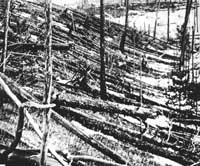New "news" from Tunguska
“ELHUYAR. The tireless collaborator of the magazine “Zientzia eta Teknika”, Alfonso Martínez de Lizarduikoa, has given us two articles under the title “The great enigma of the cataclysm of Tunguska” (see ELHUYAR. Science and Technology” numbers 66 and 67). The subject of the articles is one of the most surprising natural events of this century, that occurred in Tunisia in 1908.
In the January 7, 93 issue of the prestigious journal Nature, the latest research on this fact has been published. The author of this work is Christopher Chyba, from NASA's Goddard Space Flight Center, accompanied by Paul Thomas and Kevin Zahnle.
As Alfonso Martínez explained in his articles, the attempts made to clarify the cataclysm of Tunisia have formulated different hypotheses. Antimatería, small black holes, UFOs (Unknown Flying Objects), meteorites, etc... are those that have been used in these hypotheses as a cause of the event.

According to the work he has just published, the strange hypotheses that have been used have no place. Chyba argues a much more common phenomenon: Tunguska is the result of what an asteroid would generate when entering the Earth's atmosphere. There is, therefore, no great news, since the hypothesis of the atmospheric meteorite has been repeated on several occasions.
But there was a problem to accept these hypotheses: there are no large craters at the place of the collision. There are small craters around, but there are no ones that would correspond to a meteorite that could cause a catastrophe of this size. Therefore, those who have defended this hypothesis have announced that it could be a low-density meteorite or a comet. Thus one could explain the explosion in the atmosphere without shocks on the terrestrial surface.
Chyba and his companions propose as a cause of the catastrophe an asteroid stone of 30 m of diameter. To explain that of Tunisia would need a phenomenon capable of exploiting 10 km from the terrestrial surface and releasing the energy of a bomb of between 10 and 20 megatons. Low-density comets or meteorites (carbon asteroids) would be explosives at higher altitude. On the contrary, the iron meteorite would reach the terrestrial surface and collide.
But the main contribution of this study is not the very nature of the object (which of course conditions the following), but the effect of the aerodynamic forces that have proposed to explain its fragmentation and dispersion. As this hypothesis proposes the influence of a normal meteorite, it seems more acceptable to scientists.
On the other hand, the physics of meteorite fragmentation in the atmosphere of the Earth is similar to that of the craters of the physics of Venus, so a greater investigation is expected in this way, and thus clarify the shadows that remain around the enigma of Tunisia.
Buletina
Bidali zure helbide elektronikoa eta jaso asteroko buletina zure sarrera-ontzian











